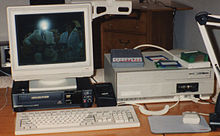- Desktop video
-
 An Amiga 2000 desktop video system. The CPU unit is to the right with the monitor sitting on a VCR.
An Amiga 2000 desktop video system. The CPU unit is to the right with the monitor sitting on a VCR.
Desktop video refers to a phenomenon lasting from the mid-1980s to the early 1990s when the graphics capabilities of personal computers such as Commodore's Amiga, the Apple Macintosh II and specially-upgraded IBM PC compatibles had advanced to the point where individuals and local broadcasters could use them for analog non-linear editing (NLE) and vision mixing in video production. Despite the use of computers, desktop video should not be confused with digital video since the video data remained analog. Full-screen, full-motion video's vast storage requirements meant that the promise of digital encoding would not be realized on desktop computers for at least another decade.
Description
There were multiple models of genlock cards available to synchronise the content; the Newtek Video Toaster was commonly used in Amiga and PC systems, while Mac systems had the SuperMac Video Spigot and Radius VideoVision cards. Apple later introduced the Macintosh Quadra 840AV and Centris 660AV systems to specifically address this market.
Desktop video was a parallel development to desktop publishing and enabled many small production houses and local TV stations to produce their own original content for the first time. Desktop video meant that television advertising on Public-access television, which had not been affordable before, became possible for local businesses such as real estate agents, contractors and auto dealers. As with the phrase desktop publishing, use of the term died out as the technologies it referred to became the norm for any kind of video production.
External links
- book
- video segment from 1990 (archive.org)
- " Source of Amiga Video Toaster Software Released" (Slashdot)
- the early use of personal computers at the BBC
Categories:- Broadcasting
- Home video
- Film and video terminology
- Film and video technology
- Internet stubs
Wikimedia Foundation. 2010.
